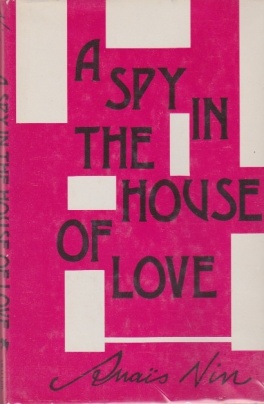What’s it about?
My first book review was about a man cheating on his woman. My second is about a woman cheating on her man. Published in 1954, A Spy in the House of Love explores subjects taboo to the era. Protagonist Sabina is unfulfilled in her marriage to Alan, to whom she feels a daughterly relationship. This book is less a straightforward “story” and more a rumination on the woman’s role as wife and lover filtered through five different relationships.
Doesn’t Anais Nin write erotica?
It’s true, Nin is best known for her collection of erotic short stories, The Delta of Venus, but these were commissioned by a collector, rather than chosen as a subject by Nin herself. In A Spy in the House of Love, Nin explores sexual relationships between main character Sabina and several men, but she does not explicitly detail their encounters, nor does she merely hint at them in the way that many chick-lit authors do. Instead, she delves into the emotional aspects of these encounters, exploring the way Sabina and her lovers feel and think rather than what they do and how they feel physically.
What did I think?
It’s hard to judge this book by modern expectations because of the time period in which it was written. Anais Nin’s writing is known for its eloquence, though at times she becomes flowery and “obvious”. She frequently spells out connections to the title throughout the body of the text, which gets to be somewhat cloying (page 51: “Her eyes like the eyes of a spy. Her habits like the habits of a spy.”). Generally, though, the text was rife with apt metaphors and poetic descriptive passages such as on page 66:
“When their still throbbing bodies lay side by side, there was always silence, and in this silence each one began to weave the separating threads, to disunite what had been united, to return to each what had been for a moment equally shared.
There were essences of caresses which could penetrate the heaviest insulations, filtering through the heaviest defenses, but these, so soon after the exchange of desires, could be destroyed like the seeds of birth.”
I did not always sympathize with Sabina. At times, I found her to be too self-pitying but also a victim of her era and her history. Each of her relationships throughout the novel explored a different aspect of herself: another version of her as a woman. Her main concern is to find a way to reconcile these different versions of herself; to find a man who will recognize each of her faces instead of the single one he wishes to see.
Overall, A Spy in the House of Love is a beautiful book. Nin explores aspects of the human psyche that everyone can relate to—not only women. At times, though, she becomes a bit preachy, and sacrifices realism for theme. Taken with a grain of salt, though, this text is thoroughly enjoyable. Definitely recommended.
3.5/5 stars



2 comments
what a thoughtful & beautiful review! I love anything to do with books. would you be so kind as to guest blog post for my site? if you’re so inclined, here’s a link to general guidelines: https://wp.me/p6OZAy-1eQ
Thank you! I’ll be sure to check it out.